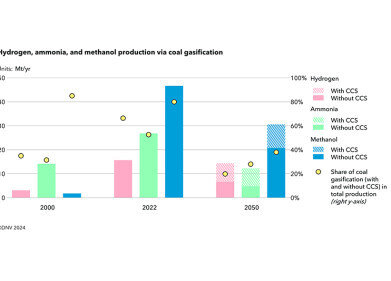Green Energy
Heat pumps - a green energy approach to heating
May 26 2021
Author credit - Stephen B. Harrison and Maria James, sbh4 consulting
Heat pumps are gaining popularity as a more environmentally friendly alternative to traditional heating boilers that use fossil fuels. The European Heat Pump Association Market data points out that in the year 2020 alone roughly 14 million heat pumps were installed across 20 EU nations. That contributed to an annual reduction of 9.16 million Tonnes of CO2 emissions. The rationale behind this growth is due to positive attributes of the heat pump, such as low greenhouse gas emissions, low energy costs, and high-performance characteristics.
A heat pump is a device that can provide heating or cooling and can be used for numerous residential, commercial, or industrial applications. The system is referred to as a heat pump, an air conditioner, or chiller depending on the service it provides. Each heat pump has five key components, namely: an evaporator, a compressor, a condenser, an expansion valve, and a heat transfer fluid, which is a refrigerant gas.
Heat pumps can be categorized based on a variety of factors. For example, heat pumps can be classified as air to air, water, or geothermal depending on the source. Air-to-air or air-source reversible heat pumps are gaining popularity in domestic applications. This is because the same unit can be used for heating or cooling. In heating mode, the indoor unit serves as the condenser and the outdoor unit serves as the evaporator. When the machine is switched to cooling mode, the mechanism reverses.
Heat pumps: advantages and caveats
A heat pump is a system that converts electrical energy into heat without combustion. The effectiveness is measured by its coefficient of performance (COP). Heat pumps have a COP of three to four which means that they can generate three to four kW of low-grade thermal energy for every kW of electrical power supplied to the system.
The high running cost of resistance wire electrical heaters has been a long-standing issue when compared to alternatives. However, with falling renewable energy generating prices and the heat pump's energy conversion efficiency, electrification for household heating is now more appealing. If the heat pump is powered entirely by renewable electricity from hydro, wind, or solar power, the heat pump will be climate-neutral and cost-effective. It could displace fossil fuels for low-temperature heating applications and thereby play a key role in achieving 2050 net-zero CO2 emissions goals.
A heat pump can also function as an integrated device that can provide heating, cooling, and hot water simultaneously. This is ideal for use in residential areas. For industrial applications, heat pumps can be combined with a waste heat recovery unit to produce useful energy from waste heat. On a broader scale, district heating and cooling can also be achieved in this way. A case study would be the town of Esbjerg, Denmark. A large heat pump system including a CO2 compressor supplied by MAN Energy Solutions uses CO2 as the refrigerant gas and heat transfer medium inside the heat pump. The heat source will be the sea, which is near to the town.
For air-sourced heat pumps, seasonal performance variations are a drawback. When the temperature plummets to between -10°C and -20°C, during extreme winter conditions, the performance diminishes. This is because the COP decreases as the temperature difference between the heat source and heat sink increases.
Modern refrigerant gases for heat pumps
To unleash the optimum performance of a heat pump, refrigerant gases play an important role. The operating conditions of a heat pump are determined by the refrigerant, which is a working fluid within the heat pump. The heat pumps offered today for residential applications employ refrigerants such as R454B and R32. Both are mildly flammable with a classification of A2L. However, it is likely that R454B will dominate in this sector because it has a GWP that is 30% lower than R32. It is therefore more sustainable.
For high-temperature applications and large heat pumps, R-1234ze is ideal. Other refrigerants with higher critical temperatures, such as butane, ammonia, and carbon dioxide are also relevant for industrial applications. The global warming contribution of these refrigerant gases is less than those of traditional F-Gases. However, Butane is highly flammable and thus can only be used in applications where this fire hazard is acceptable. The toxicity of Ammonia has also limited its extensive usage in vulnerable public buildings like schools and shopping malls.
Events
Apr 24 2024 Sao Paulo, Brasil
May 05 2024 Seville, Spain
May 13 2024 Munich, Germany
May 23 2024 Beijing, China
May 23 2024 Beijing, China














